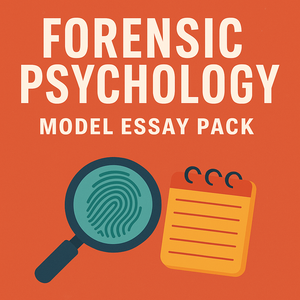How to Write a Top Band 16-Mark Essay on Social Exchange Theory (AQA A-Level Psychology)
If you've ever stared at a blank page during a psychology exam, wondering how to start your 16-mark essay on Social Exchange Theory, you're not alone. Many students find extended writing in AQA Psychology challenging, especially when it comes to balancing AO1 knowledge with AO3 evaluation. But the good news? Once you learn the structure and understand the expectations, these questions become a golden opportunity to bag marks.
In this article, we’ll break down what a top-band 16-marker looks like, explore the most common pitfalls, and show you exactly how to plan and write a model essay on Social Exchange Theory (SET). You’ll also be able to download a FREE model answer with a full commentary and revision tips.
What the Examiner Wants in a 16-Marker
The 16-mark essay is assessed using three assessment objectives:
-
AO1 (6 marks): Knowledge and understanding of psychological concepts, theories, and studies.
-
AO3 (10 marks): Evaluation, analysis, and application. This is where most students lose marks.
Your answer needs to show depth, balance, and clarity. The best way to organise your evaluation paragraphs is to follow the PBWC format:
-
Point
-
Because
-
Why this matters
-
Counterargument or limitation
What is Social Exchange Theory?
Social Exchange Theory is a cognitive theory of romantic relationships which suggests that partners weigh up the rewards and costs of their relationship. If the rewards outweigh the costs, the relationship is seen as worthwhile. If not, it may break down.
Rewards might include emotional support, shared goals, and intimacy, while costs could involve time, energy, or emotional distress. Thibaut and Kelley proposed a comparison level (CL) to evaluate current satisfaction, and a comparison level for alternatives (CLalt) to determine if a better option is available elsewhere.
Common Mistakes Students Make
-
Writing descriptive AO1 only: Many students stop at describing the theory and forget to evaluate.
-
Missing the PBWC structure: Evaluation points become vague or unsupported without it.
-
Weak counterarguments: A top-band essay includes critical thinking, not just praise.
-
Repeating the same idea: Each AO3 paragraph should offer something new.
Memory Aid: "RICE"
To help remember how to evaluate Social Exchange Theory, use the acronym RICE:
-
Real-world support (e.g. studies showing people leave when rewards are low)
-
Individual differences (e.g. cultural/gender factors)
-
Comparison to alternative theories (e.g. Equity Theory)
-
Ethical/practical limitations (e.g. assuming people are selfish)
This way, you’ll always have four clear evaluation directions ready in your head.
How to Plan Your Essay
Introduction (1-2 sentences): Briefly define SET and mention it’s a cognitive explanation.
AO1 Section (6 marks):
-
Explain rewards and costs
-
Define comparison level (CL) and CLalt
-
Reference Thibaut & Kelley
AO3 Section (10 marks): Use four PBWC paragraphs. Here’s an example of one:
One strength of SET is its practical applications. This is because it helps explain why people stay or leave relationships based on cost-benefit analysis. This is useful because it can inform relationship counselling strategies that aim to increase perceived rewards or reduce costs. However, this approach may oversimplify complex human emotions and ignore irrational decision-making in relationships.
Repeat this structure three more times using different angles (see RICE).
Ready to See a Full-Mark Answer?
We’ve created a FREE downloadable resource that contains:
-
A fully-written 16-mark essay on Social Exchange Theory
-
Clear use of PBWC in each evaluation paragraph
-
A running commentary explaining what makes each section excellent
-
Revision tips and memory hacks to help you recall content in the exam
This is a perfect resource for:
-
Students who struggle with essay writing
-
Anyone aiming for A/A*
-
Psychology teachers who want a ready-made example to share
👉 Click here to download the FREE Social Exchange Theory 16-Mark Model Answer
Final Thoughts
Writing a great 16-marker in Psychology doesn’t require being a genius. It’s about structure, practice, and knowing what the examiners want. With your AO1 nailed down and the PBWC formula guiding your AO3, you’ll be in a strong position to earn top marks.
So go ahead — read the model essay, study the commentary, and use the memory hacks to lock in the content. Your future self (and your exam results) will thank you.




